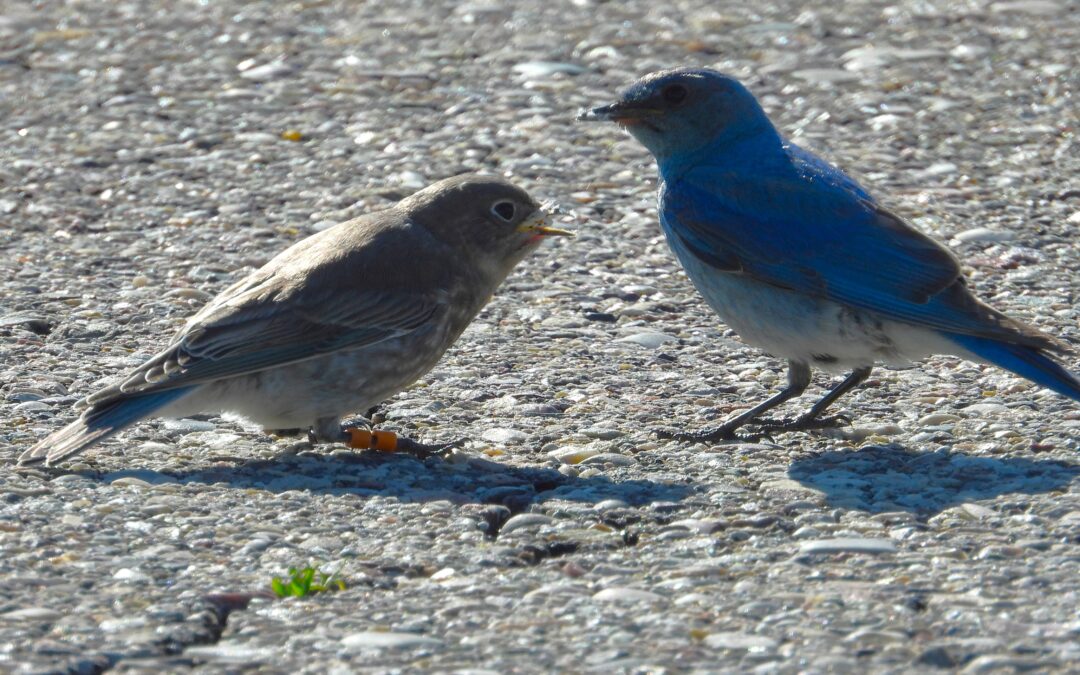
by jhwildlife | Jul 4, 2023 | Blog
By Kyle and Vicki
What purpose does our nestbox trail serve?
Mountain bluebirds are a cavity nesting species which rely mainly on holes in trees, often created by woodpeckers, to raise their young. This species of bluebird is believed to be on the decline in the West due to factors such as habitat loss and competition for limited cavity nests from invasive species like house sparrows and European starlings.

A fledgling bluebird from box 44 is fed by an adult on Monday at the Fish Hatchery. Photo Vicki Morgan.
Mountain bluebirds are among the first nesting songbirds to return to the Jackson Hole area each spring. There is likely some evolutionary strategy at play here; by returning when the ground is largely still snow covered bluebirds risk exposure to lack of food and cold temperatures, but gain an advantage over rival species when it comes to snagging limited nesting sites.
Our trail of volunteer-built nestboxes on the National Elk Refuge’s western boundary not only provides bluebirds with much needed nesting locations, but allows scientists a chance to gain a more complete understanding of the overall health of this sub-population.
How are the bluebirds faring this spring?
Overall, we’re confident 2023 has been a good year for bluebirds. While we won’t have a full dataset until the end of the summer, reports from our banding team and volunteers indicate bluebirds both returned to the trail and nested in relatively high numbers this spring.
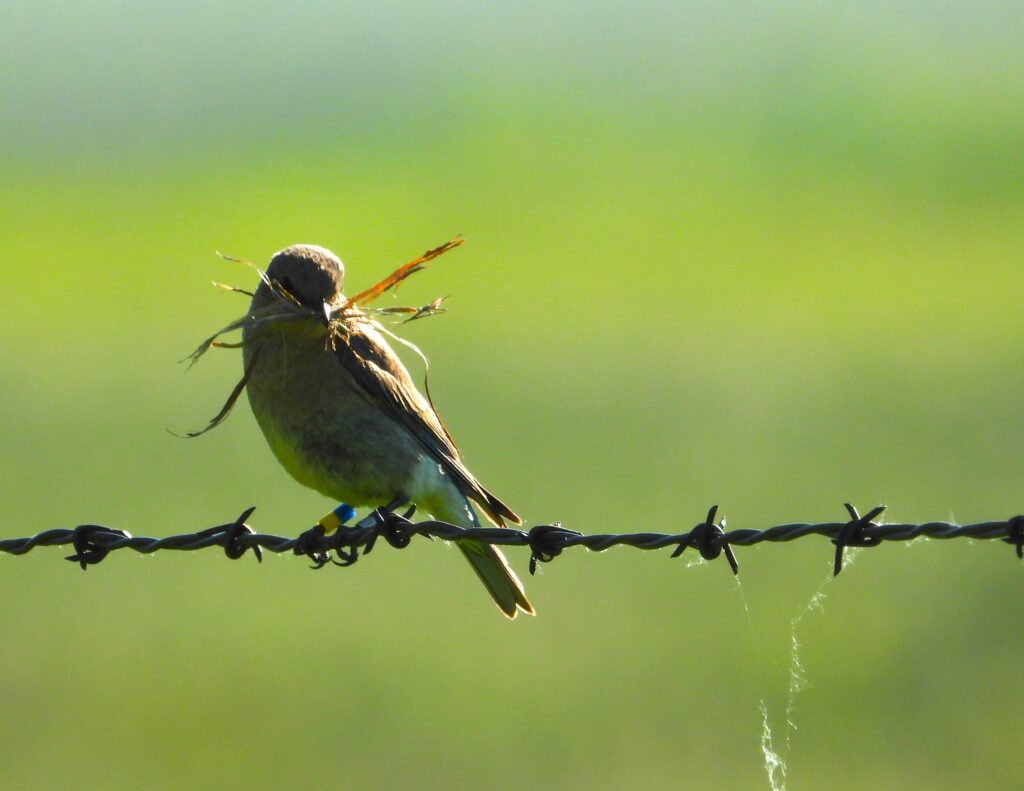
While spring conditions imperiled some nestlings early in the season, wet conditions are likely to foster increased numbers of insects later in the summer which may benefit second rounds of nests. Photo: Vicki Morgan.
At one point, 16 active nests were recorded, more than were active over the entirety of last season. According to Lead Bird Bander Vicki Morgan, who surveys boxes and organizes volunteer data weekly, there are currently two to three boxes with nestlings about to fledge, and between four and six boxes where bluebirds are on their second attempts at nest building.
Several fledglings from box 44 were even “hanging out” at the Fish Hatchery parking lot, where they were being fed by their parents as of Monday morning (don’t all go to photograph them at once!).
The success of nestboxes this year can at least partially be attributed to last year’s batch of fledglings. At least four nest boxes contain female bluebirds which were banded last year as chicks. These birds migrated away last winter and have since completed successful return journeys back to the National Elk Refuge to build their own nests, usually within hundreds of meters from where they themselves hatched. The fancy phrase for this is “site fidelity.”
What are the challenges facing this year’s nesters?
Still, bluebirds on the nest box trail have faced challenges in 2023. While nest building jumped off to a quick start, insects were slow to emerge due to late-spring weather patterns and a handful of nests failed with a lack of available food for nestlings. While nest failure is a natural and normal process, it doesn’t mean it can’t be frustrating to witness young birds not make it, especially when you’re rooting for team bluebird! Several of our boxes have also experienced predation in recent weeks. Our best guess is that weasels are the culprit – snakes can also fit through nest box holes but generally devour young birds whole. Weasels on the other hand are prone to leaving behind “nestling bits” as evidence of their transgressions.
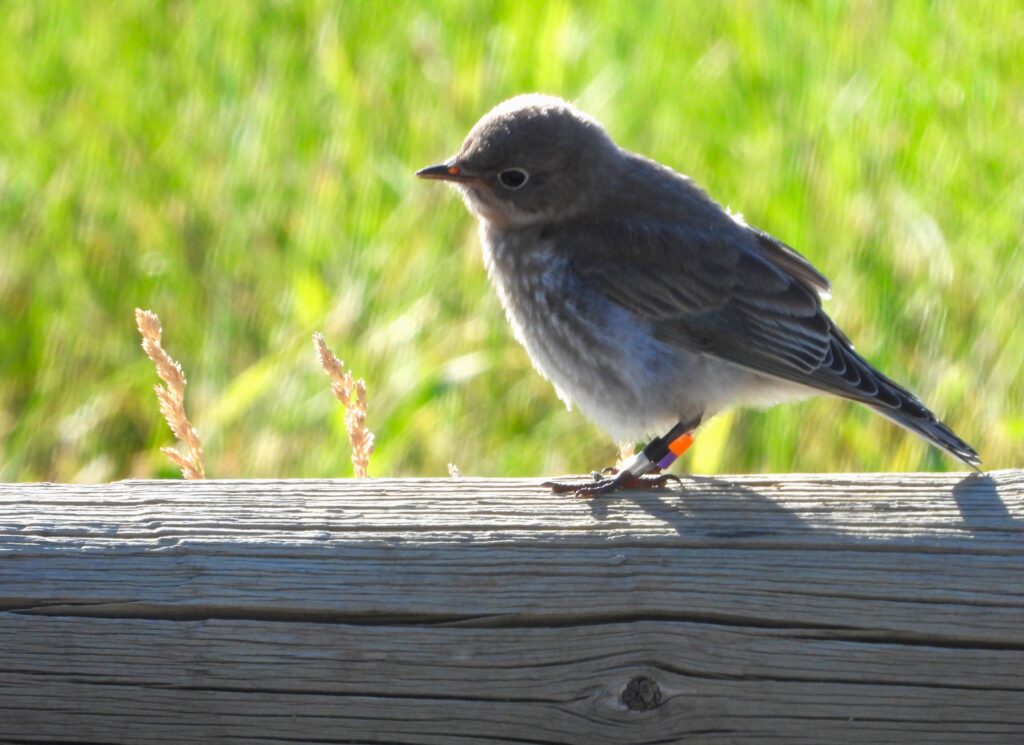
A 2023 fledgling with this year’s diagnostic color-band combination. Photo: Vicki Morgan
Are the nestboxes helpful for the birds?
We believe they are. Although not all nestling birds survive (you’re welcome weasels – for the buffet), the fact that many bluebirds do successfully fledge indicates the Mountain Bluebird Nestbox Project is likely having a net positive effect. Two years ago, a bird banded on our trail was recaptured and released in Texas during winter migration. And each year more and more “resights” of birds banded in previous years pour in. It’s going to take more than one productive year to help ensure the longevity of this species in our region, but that doesn’t mean we can’t get excited about this season’s results!
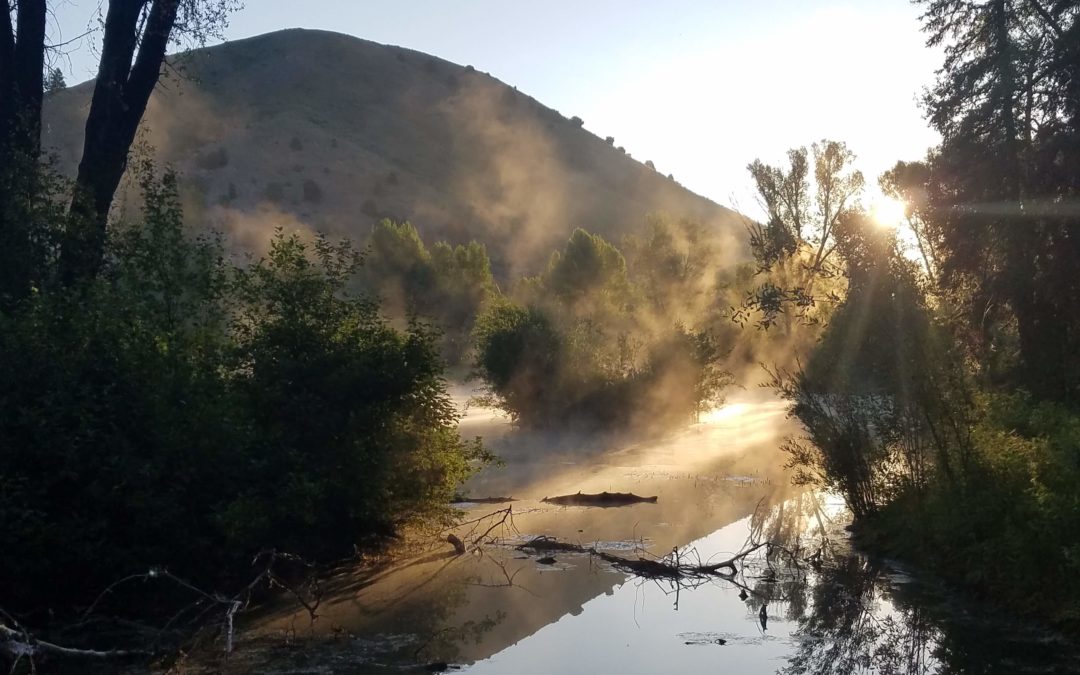
by jhwildlife | Jun 23, 2021 | Blog
Hilary Turner | Nature Mapping Program Coordinator
MAPS Bird-Banding
Our MAPS bird-banding program is experiencing an eerily slow start to the 2021 banding year.
So far, we have captured 193 birds of 32 species. Of those 130 were newly banded, 47 were recaptures, and 16 left our hands unbanded.
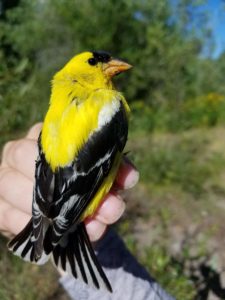 Although we are only 7 species short of our total from last year, the overall numbers are fewer than in previous years. For example, on one morning we captured zero Yellow Warblers, which are typically our most numerous species (see what we banded in 2020).
Although we are only 7 species short of our total from last year, the overall numbers are fewer than in previous years. For example, on one morning we captured zero Yellow Warblers, which are typically our most numerous species (see what we banded in 2020).
This could be correlated with the mass die-off of migratory birds that occurred last fall in the southwest (https://www.audubon.org/news/the-southwest-facing-unprecedented-migratory-bird-die) and greater Western region.
We can’t say for sure what the cause is and we won’t know exactly how different this season was until we analyze our data. However, it has been interesting to experience what has seemed like an unusually slow spring migration and start to the breeding season.
Mountain Bluebird Nestbox Monitoring
Nature Mapping citizen scientists began another season of Mountain Bluebird nestbox monitoring on May 1st 2021. Our bluebird trail is comprised of 112 boxes mounted on the National Elk Refuge fence along Hwy 89. These boxes are monitored by 14 volunteers.
These hardy volunteers brave mud, ants, and empty nestboxes to ensure accurate and quality data collection along the bluebird trail. We are ever grateful for their good work!
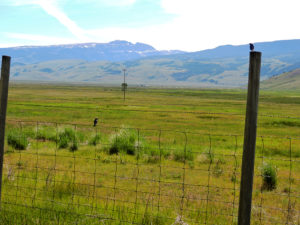 This year, seven nestboxes have been occupied by Mountain Bluebirds and many more boxes are occupied by Tree Swallows and House Wrens. The first wave of bluebird nesting is almost over, but a couple bluebird pairs have already initiated new nesting attempts for their second broods.
This year, seven nestboxes have been occupied by Mountain Bluebirds and many more boxes are occupied by Tree Swallows and House Wrens. The first wave of bluebird nesting is almost over, but a couple bluebird pairs have already initiated new nesting attempts for their second broods.
JHWF is color-banding Mountain Bluebirds as a part of our effort to understand survivorship, dispersal, and site fidelity of the bluebirds in Jackson Hole.
This year we have banded 35 Mountain Bluebird nestlings and two adults that we caught opportunistically. We also color banded two Mountain Bluebird adults that we caught at our Boyles Hill MAPS banding station.
If you see a color-banded bluebird in or near Jackson, write down the color combination, note the location, and report the sighting to reportband.gov or Hilary@jhwildlife.org!
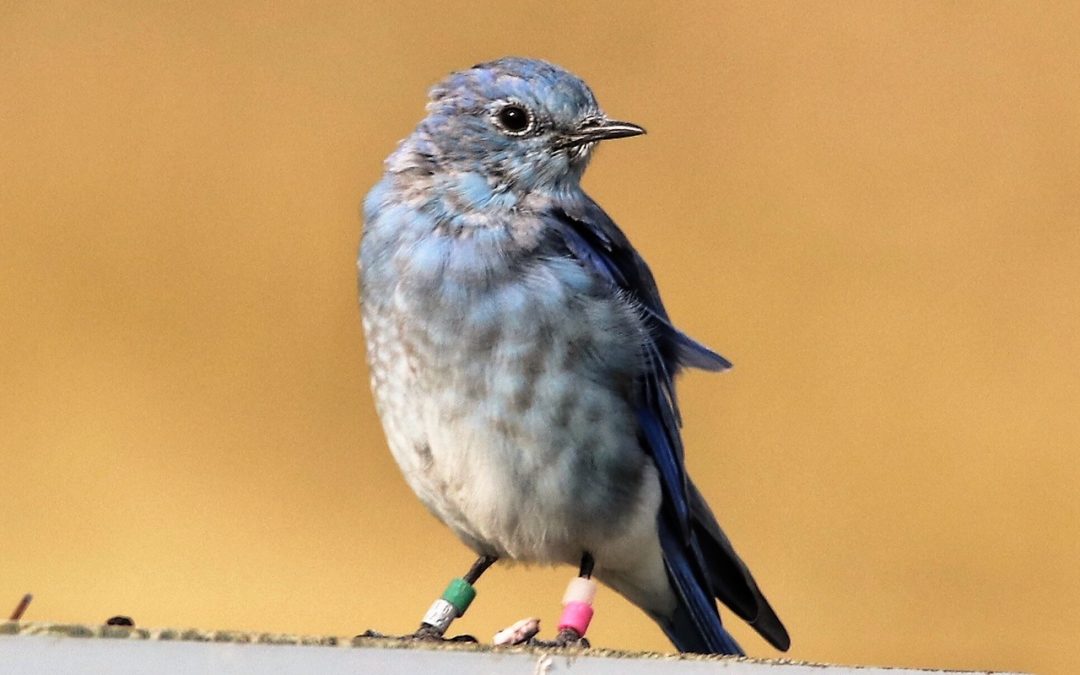
by jhwildlife | Apr 21, 2021 | Blog
How long have you been involved in Mountain Bluebird Nest Box Monitoring and do you have an estimate for how many active bluebird nests you’ve monitored?
Patti – We first volunteered in 2018 and 2019. We watched a set of 10 nest boxes, in 2018 we had 3 nest boxes that produced little baby bluebirds – it was like magic to me. We witnessed 2 sets of nestlings being banded, one nest with 5 and the other with 6.
What drew you to be a Mountain Bluebird nest box volunteer?
Patti – My first thought was “Have you see the color of those birds? Who wouldn’t want to watch them.” But really, any chance to watch birds that close up through an entire breeding and nesting season was really exciting.
Do you a specific fond or rewarding memories related to this project?
Patti – I would say the first blue egg in box 15 did it for me. Also seeing them being banded was an amazing feat by the professionals
Are there any challenges/negative aspects of being a Mountain Bluebird nest box monitoring volunteer?
Patti – Being dive-bombed by the tree swallows was not fun. They are feisty creatures and do not like visitors to their nests close to egg laying time. It’s because you have both of them protecting their box! The other challenge is being about 3″ too short to see into some of the boxes. The pocket digital camera became my assistant if Andrew was not there.
Do you have any advice you would give to new Mountain Bluebird nest box volunteers?
Patti – Use your camera to record what you see. Even if no one needs the data in picture form, you yourself will be amazed to remember the whole process in such a clear way – from the first scraps of grass to the eggs appearing one by one, to the hatchlings then to the nestlings, and then on to the abandoned box.
What is it specifically about birds that draws your interest?
Patti – Andrew is a mammalogist by training and has been interested in nature all of his life. I was a girl scout from 2nd grade through adulthood. We both love the outdoors. Andrew’s interest in birds came as he was watching mammals! My interest was a bit delayed because I thought I would never be able to spot them quickly enough and make any sort of identification. As usual, his patient teaching methods and field identification hints helped me gain skills and he is still here to help me spot field marks and bird behavior. My first life-list bird was a raven in Logan, Utah in 1980.

by jhwildlife | Oct 26, 2016 | Blog, Nature Mapping Jackson Hole
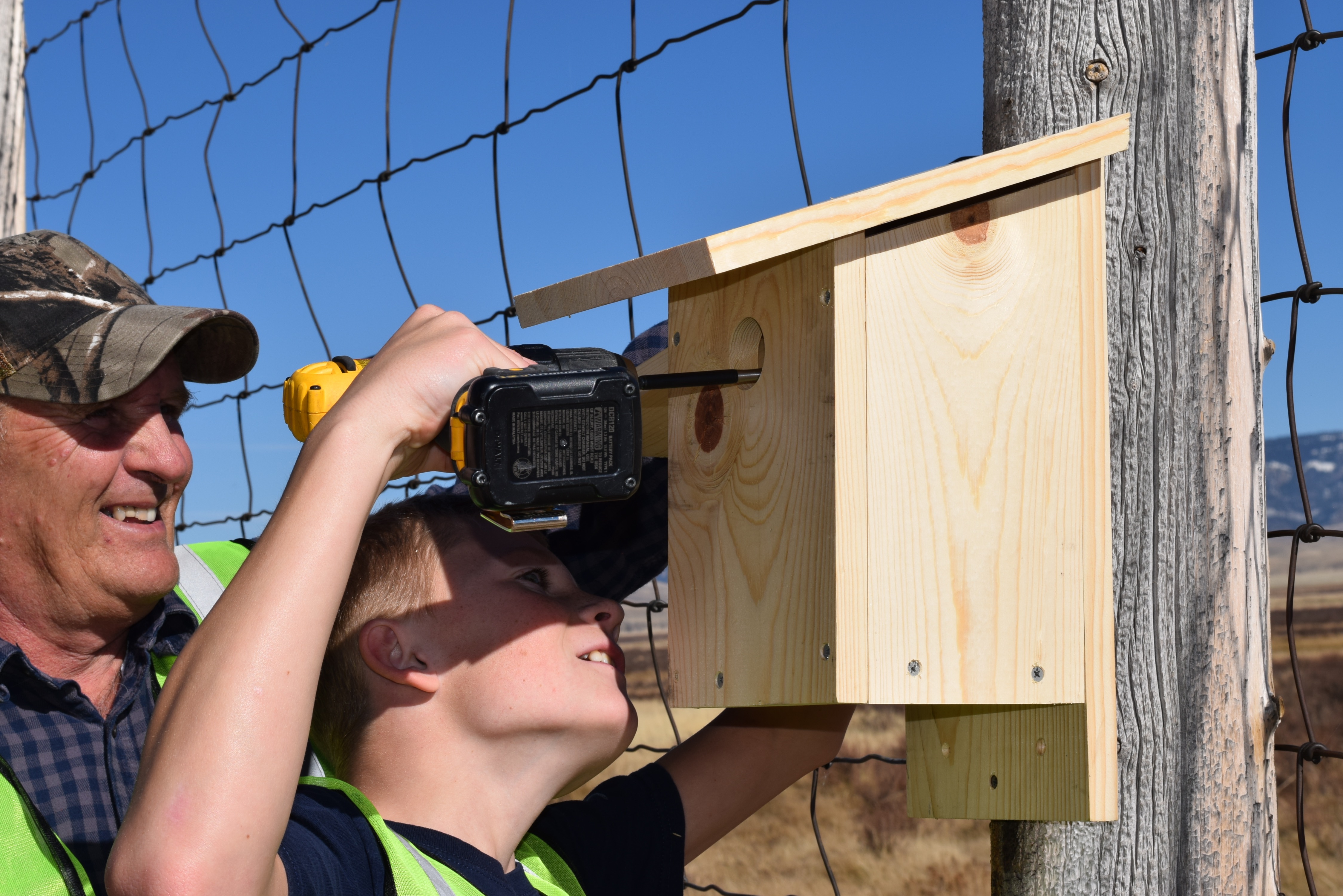
Eagle Scout is the highest achievement or rank attainable in the Boy Scouting program of the Boy Scouts of America. The requirements necessary to achieve this rank take years to fulfill, and must include completion of an extensive service project that the Scout plans, organizes, leads, and manages. Luckily for the Jackson Hole Wildlife Foundation, prospective Eagle Scout Maclain Smith from Utah, made us the beneficiary of his service project. This past Friday afternoon, Maclain came up to Jackson to install 52 Mountain bluebird nestboxes that he and fellow Scouts constructed by hand.
With lots of laughs and great spirit, Maclain and nine of his family members spent a sunny autumn afternoon installing new pinewood nestboxes on half of our Mountain bluebird trail that runs along the western boundary of the National Elk Refuge. Our old nestboxes (that served their purpose for 13 years!) were taken to Teton Recycling Center where they will be repurposed into wood mulch and used for gardening and landscaping purposes. After 13 years, we felt it time to retire the old nestboxes as they had seen many repairs over the years, but their deteriorating condition was starting to present challenges in terms of predator control and protecting nests from bad weather conditions.
Not only are we fortunate to have the help of Maclain, but we currently have two more prospective Eagle Scouts producing a total of 72 additional nestboxes that will be installed this coming spring. Of these 72 — the other half of our trail will receive 52 new nestboxes, we are looking into placing additional nestboxes elsewhere on the National Elk Refuge, and keep a few in storage. Thank goodness for Scouts!
Click here to see a photo gallery documenting Maclain installing new Mountain bluebird nestboxes with the help of his family and JHWF staff.
Click here to read an account of the project published by the National Elk Refuge.
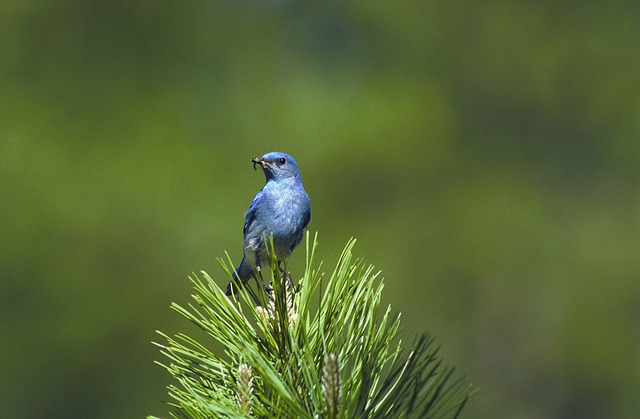
by jhwildlife | Jun 8, 2016 | Blog, Nature Mapping Jackson Hole
As a follow-up to last week’s blog post, unfortunately we have sad news to report. The nest with the five bluebird chicks seems to have been sabotaged and no observable signs exist of the chicks or their parents. Upon arriving at this particular nest box for weekly inspection, the top lid was haphazardly lying on the ground about a foot away; its screws that held it firmly in place were stripped from the wood and only just hanging on by wire. Scratch marks can be seen around the entrance hole. We can’t know for sure what happened, but we suspect we have a weasel hunting our mountain bluebird trail as other nature mappers have reported similar scenarios.
All we can do is remain vigilant to identify the predator and then devise an appropriate solution. It is a reminder to us of the nature of nature, and the circle of life in birth, survival and death — how all in nature are independent and interconnected. However, such involvement as ours through citizen science (while sometimes strongly tugging at our heartstrings) ultimately, still connects us with relevant, meaningful, and real experiences with science.












